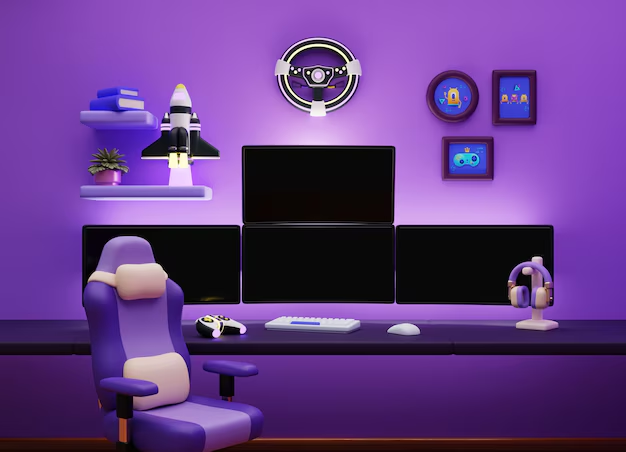Building your own gaming PC can be one of the most rewarding projects for any gamer. Not only do you get to customize every component to fit your needs and budget, but you also gain a deeper understanding of how your machine works. Let’s dive into the process step by step.
Table of Contents
Planning Your Build
Before you even think about purchasing parts, it’s crucial to plan your build. Start by setting a budget. Gaming PCs can range from a few hundred dollars to several thousand, depending on the performance you want. Consider what games you want to play and at what settings. High-end games and virtual reality will require more powerful components compared to indie or older games.
Choosing Components
Central Processing Unit (CPU)
The CPU is the brain of your PC. For gaming, you want a CPU that can handle high-speed calculations. Popular choices include the Intel Core i7 and i9 series or the AMD Ryzen 5 and 7 series. These processors offer excellent performance for gaming and multitasking.
Graphics Processing Unit (GPU)
The GPU is arguably the most critical component for a gaming PC. It handles rendering images, videos, and animations. Nvidia’s GeForce RTX series and AMD’s Radeon RX series are top choices, offering high frame rates and support for the latest gaming technologies like ray tracing.
Motherboard
Your motherboard should be compatible with your CPU and GPU. Look for features like the number of PCIe slots, USB ports, and RAM capacity. Popular brands include ASUS, MSI, and Gigabyte.
Memory (RAM)
For gaming, 16GB of RAM is generally sufficient, though 32GB offers future-proofing. Speed is also essential; aim for at least 3200MHz. Brands like Corsair and G.Skill are reliable choices.
Storage
SSD (Solid State Drive) is the way to go for fast load times. A combination of a smaller SSD for your operating system and games, along with a larger HDD for other files, is often recommended. Aim for at least 500GB of SSD storage.
Power Supply Unit (PSU)
A reliable PSU is vital. Calculate your power needs using online tools and add some headroom. Brands like EVGA, Corsair, and Seasonic are well-regarded for their reliability.
Case
Your case should fit all your components and provide good airflow. Mid-tower cases are a popular choice for their balance of space and size. Look for cases with good cable management options and enough room for future upgrades.
Cooling System
Keeping your PC cool is crucial for maintaining performance and longevity. Air cooling is sufficient for most builds, but liquid cooling offers better temperatures and is quieter. Brands like Noctua (air) and Corsair (liquid) are top picks.
Peripherals
Don’t forget peripherals like a monitor, keyboard, and mouse. A high-refresh-rate monitor can make a big difference in fast-paced games. Consider accessories like a gaming headset or controller based on your preferences.
Assembling the PC
Preparation
Before starting, gather your tools—typically a Phillips-head screwdriver—and take anti-static precautions like using an anti-static wrist strap.
Step-by-Step Assembly
- Installing the CPU: Open the CPU socket on the motherboard, place the CPU carefully, and secure it.
- Installing the RAM: Insert the RAM sticks into the motherboard slots, ensuring they click into place.
- Mounting the Motherboard: Secure the motherboard to the case using screws.
- Installing the GPU: Insert the GPU into the PCIe slot and secure it with screws.
- Connecting the Power Supply: Attach the PSU to the case and connect the necessary cables to the motherboard, GPU, and storage devices.
- Installing Storage Devices: Mount your SSD and/or HDD in the appropriate bays and connect them to the motherboard and PSU.
- Setting Up Cooling Solutions: Install any additional fans or liquid cooling components.
- Cable Management: Organize and secure cables to improve airflow and aesthetics.
Installing the Operating System
Choose an operating system, typically Windows for gaming. Create a bootable USB drive, insert it into your new PC, and follow the on-screen instructions to install the OS. Once installed, download and install all necessary drivers from your component manufacturers’ websites.
Testing and Troubleshooting
Power on your PC and enter the BIOS to check if all components are recognized. Perform stress tests using software like Prime95 (for CPU) and FurMark (for GPU) to ensure stability. If issues arise, double-check all connections and consult forums or manufacturer support.
Optimizing Performance
For maximum performance, consider overclocking your CPU and GPU. Use software tools provided by manufacturers to safely increase clock speeds. Tweak in-game settings to balance performance and visuals. Regularly clean your PC and update drivers to maintain optimal performance.
Conclusion
Building a gaming PC is an investment in your gaming future. The process can be complex, but the reward of a custom-built machine tailored to your preferences is worth it. From choosing the right components to assembling and optimizing, each step brings you closer to the ultimate gaming experience.
FAQs
How long does it take to build a gaming PC?
The assembly process can take anywhere from 2 to 4 hours, depending on your experience and the complexity of your build.
Is it cheaper to build or buy a gaming PC?
Building a PC can be more cost-effective, allowing you to choose components based on price-performance ratio and avoid the markup of pre-built systems.
What is the lifespan of a gaming PC?
A gaming PC can last 5-7 years with proper maintenance and occasional upgrades.
Can I upgrade my gaming PC in the future?
Yes, one of the main benefits of building your own PC is the ease of upgrading components like the GPU, RAM, and storage.
What should I do if my PC won’t turn on after assembly?
Double-check all connections, ensure the power supply is switched on, and consult your motherboard manual for troubleshooting steps. If the problem persists, seek help from online forums or professional services.
